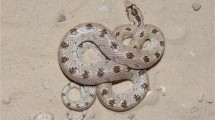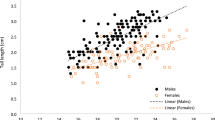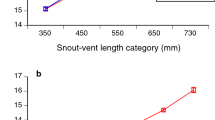Abstract
MALE sexual ornaments that increase mating success may evolve even when they decrease other components of fitness such as survival1–9. But natural covariation between the apparent level of investment in such ornaments and fitness components such as mating success, fecundity and survival, does not provide incontrovertible evidence that the ornaments are costly, because uncontrolled variables such as overall health5 may affect several components of fitness at the same time10–12. By experimental manipulation of male tail length in the monogamous swallow, Hirundo rustica, however, the effects of tail endorment can be tested directly. I show here that in such experiments, females prefer males with elongated tails over those with shortened tails13, but that males with experimentally elongated tail ornaments captured smaller, less profitable prey than those with shortened tails. Impaired foraging efficiency of tail-elongated males increased the frequency of fault bars in their tail feathers, probably as a result of food deficiency during moult. Males with experimentally elongated tail ornaments also decreased their natural tail size during moult, thereby causing a fitness loss in terms of delayed breeding and a reduced annual production of offspring resulting from reduced sexual attractiveness during the following year.
This is a preview of subscription content, access via your institution
Access options
Subscribe to this journal
Receive 51 print issues and online access
$199.00 per year
only $3.90 per issue
Buy this article
- Purchase on Springer Link
- Instant access to full article PDF
Prices may be subject to local taxes which are calculated during checkout
Similar content being viewed by others
References
Fisher, R. A. The Genetical Theory of Natural Selection 2nd edn (Dover, New York, 1958).
Lande, R. Proc. natn. Acad. Sci. U.S.A. 79, 3721–3725 (1981).
Kirkpatrick, M. Evolution 36, 1–12 (1982).
Andersson, M. Biol. J. Linn. Soc. 17, 375–393 (1982).
Andersson, M. Evolution 40, 804–816 (1986).
Hamilton, W. O. & Zuk, M. Science 218, 384–387 (1982).
Partridge, L. & Endler, J. A. in Sexual Selection: Testing the Alternatives (eds Bradbury, J. W. & Andersson, M. B.) 265–277 (Wiley, Chichester, 1987).
Pomiankowski, A. Oxford Surv. Evol. Biol. 5, 136–184 (1988).
Seger, J. Evolution 39, 1185–1193 (1985).
Partridge, L. & Harvey, P. H. Nature 316, 20–21 (1985).
Reznick, D. Oikos 44, 257–267 (1985).
Bell, G. & Koufopanou, V. Oxford Surv. Evol. Biol. 3, 83–131 (1985).
Møller, A. P. Nature 332, 640–642 (1988).
Møller, A. P. Anim. Behav. 35, 819–832 (1987).
Turner, A. K. thesis, Univ. Stirling (1980).
Turner, A. K. Anim. Behav. 30, 862–872 (1982).
Waugh, D. R. thesis, Univ. Stirling (1978).
Orians, G. H. & Horn, H. S. Ecology 50, 930–938 (1969).
Henry, C. Alauda 50, 92–107 (1982).
Rogers, L. E., Hinds, W. T. & Buschbom, R. L. Ann. Ent. Soc. Am. 69, 387–389 (1976).
Møller, A. P. Behav. Ecol. Sociobiol. 17, 401–408 (1985).
Broekhuysen, G. J. & Brown, A. R. Ardea 51, 25–43 (1963).
Mendelsohn, J. A. Transvaal Mus. 28, 79–89 (1979).
Harrison, C. J. O. in A Dictionary of Birds (eds Campbell, B. & Lack, E.) 472–474 (Poyser, Calton, 1985).
Becker, W. A. Manual of Quantitative Genetics 4th edn (Academic Enterprises, Pullman, 1984).
Sokal, R. R. & Rohlf, F. J. Biometry. 2nd edn (Freeman, San Francisco, 1981).
Darwin, C. The Descent of Man, and Selection in Relation to Sex (Murray, London, 1871).
O'Donald, P. Nature 237, 349–351 (1972).
Møller, A. P. Anim. Behav. (in the press).
Kirkpatrick, M. Am. Nat. 125, 788–810 (1985).
Kirkpatrick, M. Am. Nat. 127, 222–240 (1986).
Author information
Authors and Affiliations
Rights and permissions
About this article
Cite this article
Pape Møller, A. Viability costs of male tail ornaments in a swallow. Nature 339, 132–135 (1989). https://doi.org/10.1038/339132a0
Received:
Accepted:
Issue Date:
DOI: https://doi.org/10.1038/339132a0
This article is cited by
-
Reduced ornamentation became elaborated in benign environments in Pacific Swallows
Journal of Ornithology (2024)
-
Experimental tail shortening affects feeding rate depending on original tail length in female barn swallows Hirundo rustica gutturalis
Journal of Ethology (2020)
-
Egg size decreases with increasing female tail fork depth in family Hirundinidae
Evolutionary Ecology (2017)
-
Experimentally reduced male ornamentation increased paternal care in the Barn Swallow
Journal of Ornithology (2015)
-
Horn Growth and Reproduction in a Long-Lived Male Mammal: No Compensation for Poor Early-Life Horn Growth
Evolutionary Biology (2015)
Comments
By submitting a comment you agree to abide by our Terms and Community Guidelines. If you find something abusive or that does not comply with our terms or guidelines please flag it as inappropriate.



